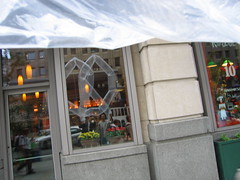I thought I’d dig out and edit down some old email conversations I’ve had about making inflatables. After making the networked rabbits I’ve had occasional emails over the years asking about the best way of building various air filled projects. This is a summary of a couple of my responses.
Basic answer is just get making! I put off starting to make inflatables for quite a while, trying to find the right plastic, etc..
Then just tried making one with a computer fan, a bin bag and some sellotape (scotch tape) that worked great.
You can get computer fans from larger computer or electronics shops. they look like this.
You can find them in an old thrown away computer too (just unscrew the case and unplug it from the main circuit board).
Computer fans tend to run on 5, 9 or 12 volts. They tend to not mind too much if you run them at the wrong voltage either (within reason), so just find an old power supply that you’re not using (it should have the voltage and the polarity of the wires written on the sticker on the back).
How big do you want your inflatables to be? these computer fans are only good for small (pillow sized) inflatables.
Do you need them to react to things, or just ‘breath’ a little?
You can use lots of materials. If you want to use fabric, try kite material. My rabbits were lined with light bin bag plastic to keep them more air tight and then wrapped in satin-finish material. The satin alone actually held the air pretty well, but took too long to re-inflate for my needs.
Lots of ideas in this book if you can find it:
http://www.amazon.com/Blow-Up-Inflatable-Art-Architecture-Design/dp/3791326872
The Ant Farm group did a lot of large scale inflatable projects. I ran across one of their original guides to making inflatables from the 70’s, but they’re hard to track down. They have info on a dvd too. More inspiring than useful information, but good to watch if you can find it:
http://www.microcinemadvd.com/product/DVD/286/Ant_Farm_Video.html
They suggest melting plastic together rather than sticking with tape to build shapes. I found melting too fiddly for small scale projects. But foil wrapped around the seam to stop it sticking and then an old iron or hair straighteners should work for some plastics.
Simplest control of inflation is:
- turn on the fan for a while
- turn if off
- on again
- etc..
A more complicated system would change the fan speed, but i don’t think that’s really necessary.
To turn the fans on and off, you can use a micro controller (a small chip you can program), but you would have to buy or make a circuit board. PIC and ATMEL are two ranges of these chips. I used PICs because I had inherited a whole load for free, but building circuit boards is a little pricey for small numbers and a little laborious by hand. So instead, especially if you’re new to this type of electronics, I’d suggest you check out this project:
http://www.arduino.cc/en/
which took it’s inspiration from this project:
http://wiring.org.co/
“Arduino can be used to develop interactive objects, taking inputs from a variety of switches or sensors, and controlling a variety of lights, motors, and other outputs. Arduino projects can be stand-alone, or they can be communicate with software running on your computer (e.g. Flash, Processing, MaxMSP.) The boards can be assembled by hand or purchased preassembled; the open-source IDE can be downloaded for free.”
 For bigger inflatables you’ll need a big purpose made inflatable blower. Another way to inflate a structure and make it float is to use helium (more costly but longer lasting) or heated air (cheaper but short-lived). We used helium to make a giant inflatable pretzel. Check out some of Otto Piene’s work for more examples of large scale inflatables of this sort.
For bigger inflatables you’ll need a big purpose made inflatable blower. Another way to inflate a structure and make it float is to use helium (more costly but longer lasting) or heated air (cheaper but short-lived). We used helium to make a giant inflatable pretzel. Check out some of Otto Piene’s work for more examples of large scale inflatables of this sort.
And yes, I do wish I’d thought of Joshua Allen Harris‘s subway airvent inflated animals – such a lovely design and motion. And for me a nice evolution from Michael Rakowitz’s HVAC inflated and heated paraSITE homeless shelter too.
